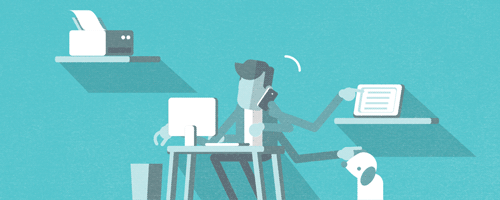Life as an Engineer is very busy and requires a lot of effort and commitment. Often times we’ll find ourselves in situations wherein there’s just so much that needs to be done in such a short amount of time, and eventually we’ll be forced to do several things at once. This is where multitasking comes in.
The question is, how do you multitask? I’m sure at least a few of our attempts on multitasking end up with either finishing them, but having the quality of work be subpar, doing one (or more) of the tasks mindlessly and forgetting where you put the paper, the wires, your soldering iron, or with us becoming physically and mentally exhausted during the process and maybe not even finishing the tasks at all.
Yes, multitasking is hard, and some folks can’t even seem to do it at all. But that doesn’t mean there isn’t an easier (and more proper) way of doing it. That’s what we’re here for. Here are tips on helping you multitask better whilst keeping the quality of your work good and exhausting less of your energy.
1. Multitask only when necessary
Source: Tenor
You might think that it’s better to multitask whenever possible so that it’ll help you practice it better. But in reality, habitual multitasking can actually hurt us in the long run by causing unnecessary stress and fatigue. Along with depriving our ability to learn how to do a specific task well. So only multitask when you absolutely have to, not because it’s convenient. Examples of when you can multitask are when there is a lot of work that needs to be done because your colleague is on vacation and the deadline is close by and there’s no one who can fill in for them. Or maybe when you find out about this huge event that you or your company will be taking part of on such a short notice. There are many others.
2. Multitask either an easy and repetitive task with a slightly harder task that requires more of your attention

Source: Tumblr
The main culprit for most of multitasking’s undesirable side-effects is the fact that people often times multitask two (or more) difficult tasks together. This will not only cause a lot of stress, but also wear you out and cause the quality of your work to suffer.
First, let’s look at the science of how our brain multitasks. Our brain categorizes our tasks into 2- a conscious task, and an automatic task. Automatic tasks are things like eating, walking, exercising, and other stuff that our brain can do by itself without requiring us to pay much attention to it. Conscious tasks, on the other hand, are things that our brain requires a lot of our attention to finish, like fixing a broken circuit board or assembling car part. Our brain can only handle 1 conscious task at a time, BUT it can do several automatic tasks at once.
So in a way, our brain can and cannot truly multitask. Hence, best way to get around this is to multitask a few simple and/or repetitive tasks. For example, printing several documents or supervising your colleagues, with 1 harder task that requires more effort like, making a machine thing or patching up a television. That way, your brain will register those simple and repetitive tasks as an automatic task, whilst doing 1 conscious task that needs more attention an energy. This is the proper way to multitask and will make it seem a lot easier, along with reducing the stress and fatigue we often get when not doing it properly.
3. Don’t multitask when the stakes are high

Sourc: Giphy
If there’s a task that requires your full attention due to the risks involved when an error occurs, DO NOT multitask. If you’re making plane parts that require precision up to the 6th decimal place, unless you want another plane to crash and put thousands of lives in danger, you wouldn’t give it your divided attention, would you?
4. Don’t let multitasking turn into a mindless process

Source: LegalInsurrection
While I did tell you to let some of those simple and repetitive tasks turn into an automatic task so that your brain can handle them better, at least pay little attention to it. Turning these automatic tasks into a completely mindless process often results to errors in your work and forgetting where you put those electrical supplies you needed. Pay even just a little bit attention to them so that you could at least remember where you put that soldering iron.
5. Know your limits

Source: ReplyGif
Know how much multitasking is too much multitasking for you. Just because you’ve finally got the hang of multitasking doesn’t mean you can keep doing it until 4am and there’s 0 energy left in you. If you feel very tired, stressed, fatigued, or sleepy, stop and take a break. And if possible, just leave it for the next day. A full night’s rest will replenish your body’s needs and help you continue your work better the next day.
So fellow Engineers, I hope this article will help you learn a few things on how to get the most out of multitasking with the least undesirable side effects it can cause you. I wish you all good luck and rock on with whatever you’re doing now that you know how to multitask properly.
Article Sources





















